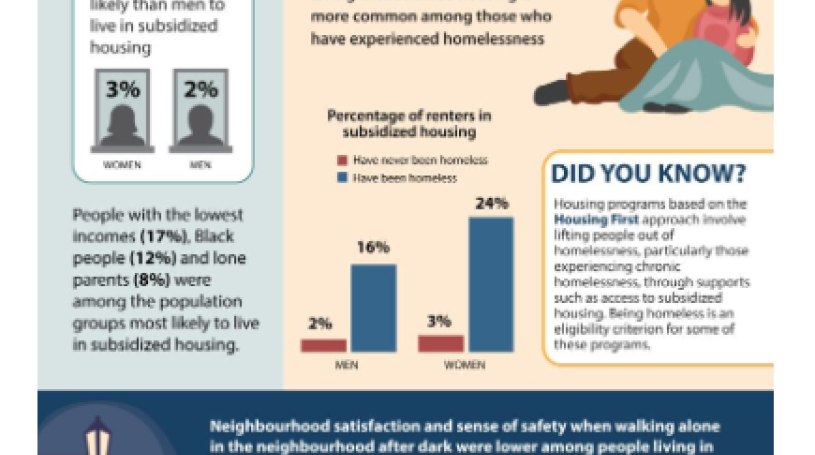Statistics Canada releases new study on women in subsidized housing
Released: 2023-04-11
In Canada, the right to suitable and affordable housing is recognized by the National Housing Strategy Act. Recent rises in consumer prices and the simultaneous housing squeeze have turned and amplified the spotlight on housing needs.
Today, Statistics Canada is releasing a study, entitled "Women living in subsidized housing in Canada." The study provides the profile of Canadians living on subsidized housing, with an examination of gender differences in dwelling and neighbourhood satisfaction.
In 2021, approximately 842,000 (3%) people aged 15 years and older lived in subsidized housing in Canada. Specifically, 507,000 women (3%) and 335,000 men (2%) lived in this type of housing, whether it be rent assistance, rent supplement, rent allowances or rent geared to income.
Living in subsidized housing is more common among those who have experienced homelessness
Living in subsidized housing was more common among certain population groups. For example, among women, the highest proportions living in this type of housing included Black women (14%), single mothers (9%), and those who were separated, divorced, or widowed (7%).
In addition, for those who have experienced chronic and episodic homelessness, subsidized housing can provide safer and more stable housing necessary to exit homelessness. This is reflected in the findings of the study which show that nearly one-quarter (24%) of women who had ever been homeless were living in subsidized housing in 2021. This is eight times the rate of women living in subsidized housing who never experienced homelessness (3%). The impact of homelessness was similar for men.
Neighbourhood satisfaction and sense of safety are both lower among people living in subsidized housing
Feelings of satisfaction with the dwelling and neighbourhood, as well as perceptions of personal safety and security, are important dimensions of well-being.
Study results reveal that both men and women living in subsidized housing were more likely to be dissatisfied with the safety and security of their dwelling, as well as the overall quality of life in their neighbourhood, than their counterparts living in non-subsidized rental housing. The gaps in satisfaction were particularly evident among women.
Specifically, women in subsidized housing (13%) were almost twice as likely as those in non-subsidized rental housing (7%) to feel dissatisfied with the safety and security of their dwelling and twice as likely to be dissatisfied or very dissatisfied with their overall neighbourhood (12% versus 6%).
Women in subsidized housing were also less likely to feel very or reasonably safe walking alone in their neighbourhood after dark (45%) than women not living in subsidized rental housing (61%).
Note to readers
The study was sponsored by Women and Gender Equality Canada.
Results are based on data from the 2021 Canadian Housing Survey, a survey sponsored by the Canadian Mortgage and Housing Corporation. The target population of the survey is private households across provinces and territories of Canada. In this survey, collective dwellings, for example, nursing homes, senior's residents, and shelters are excluded.
The results on neighbourhood satisfaction are based on the answers of the person responsible for housing decisions in their household only. These answers do not necessarily represent the perception of all people living in the household.

